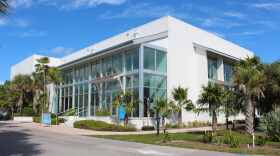

It’s been several months since beachgoers in Southwest Florida have had to worry about waters tainted with red tide or blue-green algae.
It appears it will remain that way for the foreseeable future.
The immediate concern this weekend will be the heat, which is expected to be oppressive, intense, and dangerous. Afternoon showers are not expected Saturday due to a “sprawling plume of Saharan dust” blanketing South Florida.
That’s a considerable amount of extremely dry air carrying dusty, sandy-like particles across the Atlantic Ocean, where the dust and the hot air settle down over places like Southwest Florida. It also happened in May and June.
- More on the story: Saharan dust layer turns down storms, turns up heat
Even brief stops at the shore can be risky without staying hydrated and seeking ample shade.
The National Weather Service has forecast a “major” heat risk, with highs expected to reach up to 95 degrees.
The heat index, which is not just what a thermometer reads but how hot it actually feels, is expected to spike up to 115 degrees. That means a day at the beach can turn deadly, as heat exhaustion and heatstroke are serious dangers.
“The lack of cloud cover combined with ample sunshine will result in forecasted high temps in the low to mid 90s along both coasts with temperatures in the upper 90s possible across a wide swath of inland southern Florida,” the NWS wrote in its forecast. “Be sure to stay hydrated, take frequent breaks in the AC, and always look before you lock your vehicle for pets and children.”
Saharan dust can initiate a chain of chemical reactions that may lead to a red tide, but any connection is indirect and not yet fully understood. Scientists focus on nutrient pollution as the most crucial factor in red tide blooms, with the Saharan dust playing a secondary but potentially notable role.
“Be sure to stay hydrated, take frequent breaks in the AC, and always look before you lock your vehicle for pets and children.” - The National Weather Service
Recent water sampling and satellite analyses indicate that many shorelines, such as Barefoot Beach and Vanderbilt Beach, are unlikely to experience a red tide bloom in the near future. However, other areas in Lee County, including the mouth of the Caloosahatchee River, have background concentrations of the noxious algae bloom.
No fish kills or respiratory irritation related to red tide were reported to FWC's Fish Kill Hotline during the past week.
Blue-green algae, a persistent problem for Florida’s freshwater lakes and streams, is undergoing its typical seasonal resurgence fueled by high temperatures and nutrient-rich runoff.
Inland freshwater sites like Lake Okeechobee and Lake Olivia have bloom advisories. Algae blooms can appear as green scum, paint-like streaks, or floating mats and can release toxins that are dangerous to pets.
Don’t swim or wade in water where blooms are visible, and always wash skin and clothing if you come into contact with tinted water.
Satellite images from NASA show blue-green algae is coating about a third of the northern portion of Lake Okeechobee, which is not uncommon for this time of year.
The better news is that nowhere else is the algae prominent. Trace amounts are in the water at the Alva Boat Ramp on the Caloosahatchee River, but that’s it in the region.
This is not the first time Saharan dust has inundated the region this year.
In late May, a mass of very dry, dusty air that formed over the Sahara Desert traveled thousands of miles to unload its dust and heat on South Florida.
NOAA also explains the phenomenon in detail online.
“The Saharan Air Layer has unique properties of warmth, dry air, and strong winds that can act to suppress hurricane formation and intensification,” NOAA wrote online to explain the dust layer. “Thanks to recent advancements in satellite technology, we can better monitor and understand the SAL, from its formation over Africa, to its interactions with tropical cyclones, to its impacts on weather along the U.S. Gulf Coast and Florida.”
Environmental reporting for WGCU is funded in part by Volo Foundation, a nonprofit with a mission to accelerate change and global impact by supporting science-based climate solutions, enhancing education, and improving health.
Sign up for WGCU's monthly environmental newsletter, the Green Flash, today. WGCU is your trusted source for news and information in Southwest Florida.
We are a nonprofit public service, and your support is more critical than ever. Keep public media strong and donate now. Thank you. WGCU is your trusted source for news and information in Southwest Florida. We are a nonprofit public service, and your support is more critical than ever. Keep public media strong and donate now. Thank you.








